SEQUELS
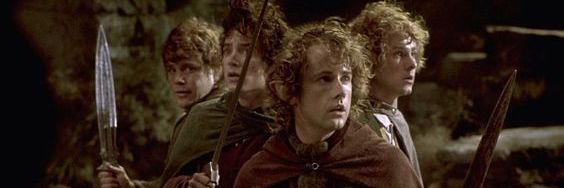
Despite the bad rap they always get, I’m actually a fan of sequels. They have the unique opportunity to bring us back to a place that we already know even though it doesn’t exist. When done right, they further develop an emotional journey that we witnessed and exceed our greatest expectations that came with the first installment.
But after getting out of yet another miserable sequel of a once awesome movie, I’m faced with the same old question.
Why do they suddenly forget how to write a fucking screenplay?
I mean they did it right the first time. The motives and character developments were solid, the plot had a decent pace and the emotions seemed to be oh so crystal clear. Everything work out. That’s the reason why they were able to do a sequel in the first place. Because they made a good movie. And then suddenly, as the second installment comes around everything is all over the place. The story is almost non-existent. Characters get introduced without any reason at all…and are killed off minutes later. The motivations of the main protagonist are a mess. Like an actual mess that no one seems to be able to unravel.
And no line of witty dialogue or a well rehearsed action scene is capable of covering that up.
THE SECRET OF THE SEQUEL
But the most frustrating part about it..it’s not that hard to write a good sequel. Honestly. The secret is actually surprisingly simple. And I will prove it to you using one of the best sequel in movie history:
The Harry Potter saga. Especially it’s first three installments: Philosopher Stone, Chamber of Secrets and Prisoner of Azkaban. With a very simple trick J.K. Rowling managed to capture an audience for years on end and create one of the most immersive fantasy-worlds in modern writing.
So if your are a movie buff that is sick and tired of awful sequels or you are a producer, screenwriter, filmmaker and eager to continue your story, listen up. Because here is the secret to Harry Potters immense success…
It’s all the same story.
KNOW YOUR GENRE
Now despite IMDb or common believe the Harry Potter movies aren’t actual fantasy stories. Sure they have magic and dragons and stuff, but in their core the movies (and books) are mystery stories. Three young students on their way to discover a mystery that needs to be solved. Gregory Austin McConnell actually described that pretty well in his essay on ,The cursed child’ and why it didn’t seem like a normal ,Harry-Potter-Story’.
So each year again and again Harry, Ron and Hermione come across a mission that they need to solve. They gather clues and informations and go on to overpower the bad guy with wit, skill and bravery. And although that doesn’t seem like much, most sequels forget what genre the original movie was even in. Because genre is not defined by the costumes, special effects or set pieces of the movie. It’s defined by its writing.
Side note: One solid way testing of whether a story is a mystery or an action adventure is by looking at it’s climax. An action adventure usually ends with an epic battle of good versus evil. Whereas in the Harry Potter stories…they are just talking. And I don’t say thats bad. I like the talking. But there is a lot of it!
The fact, that Harry Potter stories are mysteries becomes also fairly obvious when you watch (or read) Chamber of Secrets, where one of the characters is actually called Tom Riddle. The clue is in the name. And this leads me to the next similarity between all three of the movies.
MYSTERIOUS BAD GUY
 The antagonist. When Harry first discovers Toms Diary he takes him as a fine young man. He believes his stories and follows his advice. It’s only later on that he discovers that said young man is actually Lord Voldemort. Now this twist in character is seen almost throughout the entire Harry Potter franchise.
The antagonist. When Harry first discovers Toms Diary he takes him as a fine young man. He believes his stories and follows his advice. It’s only later on that he discovers that said young man is actually Lord Voldemort. Now this twist in character is seen almost throughout the entire Harry Potter franchise.
Lets take a look at year one: There we have Professor Quirrell who is portrait as a shy, stuttering mite only to find out the he was scheming to steel the philosopher stone all along. Even more important is the surprising turn of Professor Snape. Harry, Ron and Hermione strongly believe that he is eager to steal the stone himself, when in reality he tried to protect it.
In the second book (and film) this shift is seen in Professor Lockhart who is introduced as a stunning wizard. But when his moment comes he reveals himself to be a cocky liar who doesn’t know anything about anything. Tom Riddle on the other hand, who seemed so innocent, is revealed to be the true antagonist. Even the usual suspect Draco Malfoy is declared innocent when we find out, that it was the little Ginny who set the Basilisk free.
Not to bore you, but to complete the example, we go on to the third installment. There we have Sirius Black, in my opinion the greatest written character in human history, who is introduced as the most dangerous criminal the wizzarding- (and muggle-) world has ever seen. After Lord Voldemort that is. Only to discover later in the story that he was the good guy all along and that it was Ron’s Rat Scabbers aka Peter Pettigrew who committed all these crimes.
So every time we have a surprising change in character. It’s a motive that keeps recurring so I’m pretty sure you can find the character twist in the fourth book on your own.
,But this is merely a similarity in theme not in structure‘, you might say. And sure, although all these characters identities are revealed at roughly the same time in the story, I might let you have the argument. So lets dig deeper.
SAME PROCEDURE AS LAST YEAR
Each year starts with Harry being at the Dursleys.
Having the same starting point, just like in a sitcom really helps to capture the audience expectation of the previous movie.
But the Dursleys are boring. We want something magical to happen. So sure enough, in his first year, Harry frees a snake at the zoo. On accident of corse. Next year Dobby destroys the desert. Something that Harry didn’t plan on either. And in the third movie Harry blows up his aunt. This happens at almost the exact time in each book and get’s Harry in some trouble. Luckily there is someone or something to help him out of it. In book one Hagrid comes along and declares that Harry is indeed a wizzard. Second year it’s the Weasley Brothers who do the saving. And lastly we have the Knight Bus arriving to save the day.
It’s the exact same procedure each year again. Harry is at the Dursleys. He does something magical, gets into trouble and is saved by an ally. Same for all three stories? Then lets move on.
SAME PROCEDURE AS EVERY YEAR
 One of the more ingenious ideas of J.K. Rowling is aligning the plot points of the story arc with the holidays of the year. So when Halloween comes around you can be sure something will happen. It’s a troll in the dungeons! Oh, there is a bloody message on the wall. Sirius attacked the fat lady. It’s the time of ghosts and horror. So let the bad guy close in. They might as well close the school over Halloween, because it’s getting way to dangerous.
One of the more ingenious ideas of J.K. Rowling is aligning the plot points of the story arc with the holidays of the year. So when Halloween comes around you can be sure something will happen. It’s a troll in the dungeons! Oh, there is a bloody message on the wall. Sirius attacked the fat lady. It’s the time of ghosts and horror. So let the bad guy close in. They might as well close the school over Halloween, because it’s getting way to dangerous.
Luckily Christmas isn’t far away. And it’s the Holiday of joy and love. And present!
So let’s give Harry something to help him defeat the bad guy. Like a cloak that makes him invisible. Or a potion that turns him into someone else. Or a map that let’s him get around unseen. It is Christmas after all…
And there are more patterns like this. Quidditch is there to hurt Harry. Whether it’s his broomstick that is out of control, or the Bludgers or the Dementors.
The forbidden forrest adds tension. And in order to get to the bad guy, Harry has to go down – like actually underground.
CHARACTERS
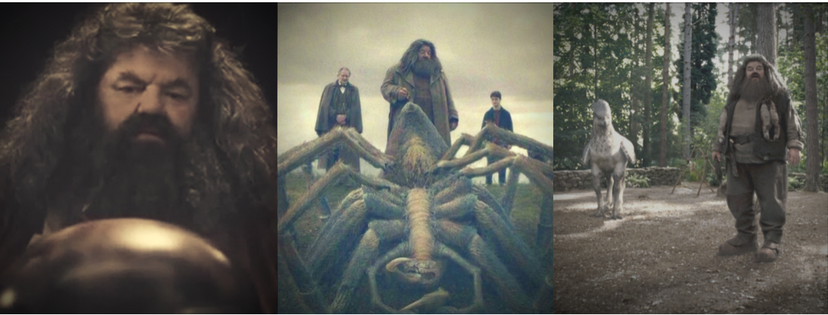 But not just the events in Hogwarts are boiled down to their singular meaning. Every character in the Harry Potter story has one purpose and one purpose only. They act on the framework of their personality and help or hinder Harry in his mission to save the wizzarding world.
But not just the events in Hogwarts are boiled down to their singular meaning. Every character in the Harry Potter story has one purpose and one purpose only. They act on the framework of their personality and help or hinder Harry in his mission to save the wizzarding world.
Lets take Hagrid for example. He sure likes his creatures. That is his mayor character property. And every year he gets himself and one of his creatures into trouble. In the first year Harry, Ron and Hermione need to help him get rid of his Baby Dragon Norbert. Next they visit his pet Spider Aragog to prove his innocence. In the Prisoner of Azkaban they free Hagrid’s Hippogriff Buckbeak that is sentenced to death.
It’s a repeating pattern, that always stays the same. In each of the three stories Hagrid has some trouble with one of his creatures and needs help from our protagonists. And it’s not just Hagrid who keeps on playing the same song over and over again. But I’m sure you figured that out by now.
THE FINAL
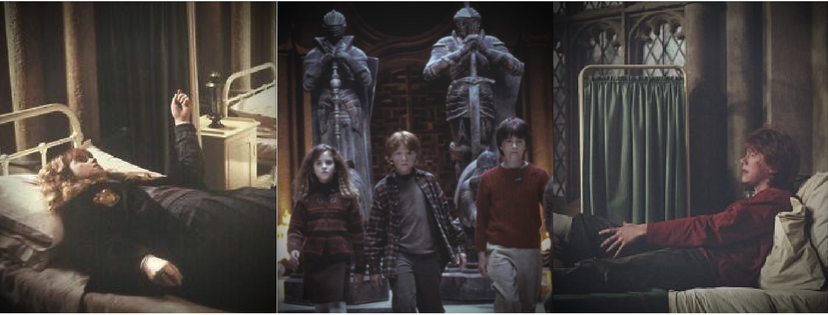 So now that Hagrid is saved from his troubles lets focus on the bad guy, alright? We are almost at the end of the year. Harry, Ron and Hermione have gathered enough intel to take on the bad guy. But since Harry is our Hero he has to face him on his own. So let’s have Ron fall from a horse and Hermione not drink the potion. They’ve done their part. Harry can go on on his own now. Well next year is no different apart from the fact, that Hermione got knocked out pretty early on, leaving Ron and Harry to go down the Chamber of Secret. And if you think this is unfair and that Hermione should get her screen time as well, just take a look at Prisoner Of Azkaban, where it’s Ron who stays in the Hospital bed so that Harry and Hermione can pair up to save the world.
So now that Hagrid is saved from his troubles lets focus on the bad guy, alright? We are almost at the end of the year. Harry, Ron and Hermione have gathered enough intel to take on the bad guy. But since Harry is our Hero he has to face him on his own. So let’s have Ron fall from a horse and Hermione not drink the potion. They’ve done their part. Harry can go on on his own now. Well next year is no different apart from the fact, that Hermione got knocked out pretty early on, leaving Ron and Harry to go down the Chamber of Secret. And if you think this is unfair and that Hermione should get her screen time as well, just take a look at Prisoner Of Azkaban, where it’s Ron who stays in the Hospital bed so that Harry and Hermione can pair up to save the world.
IN CONCLUSION
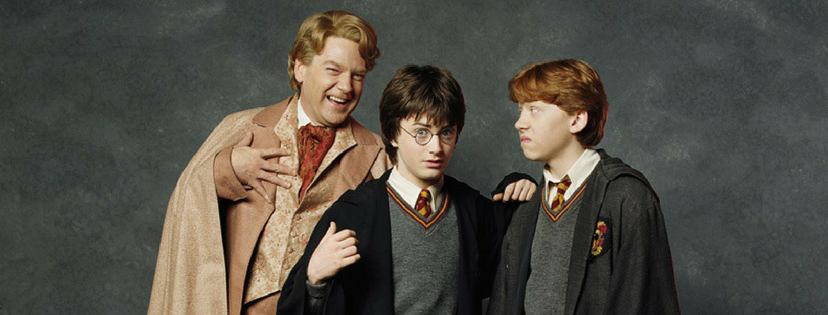 So these are just a few similarities between the three first books of the Harry Potter franchise. It’s actually quite the fun exercise to find the similarities between the stories. I have only pointed out the major plot points, but when you dig deeper, you will find different character flaws, situations or even sentences that are repeated throughout the series. I’m sure you will be able to find some more parallels on your own. And I’m also sure, that you might be able to figure out why the Order Of The Phoenix didn’t seem to work that well. But before you start screaming, heres a little disclaimer.
So these are just a few similarities between the three first books of the Harry Potter franchise. It’s actually quite the fun exercise to find the similarities between the stories. I have only pointed out the major plot points, but when you dig deeper, you will find different character flaws, situations or even sentences that are repeated throughout the series. I’m sure you will be able to find some more parallels on your own. And I’m also sure, that you might be able to figure out why the Order Of The Phoenix didn’t seem to work that well. But before you start screaming, heres a little disclaimer.
DISCLAIMER
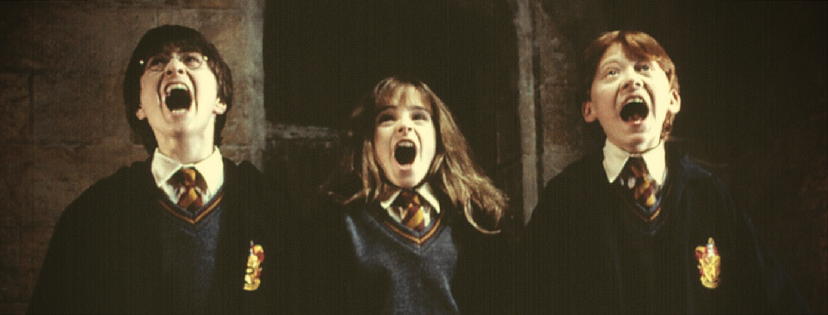 I’m not writing all this to denigrate J.K. Rowling. I’m not saying: Oh she’s so lazy. She just wrote the same story over and over again and made millions of dollars off of i’.
I’m not writing all this to denigrate J.K. Rowling. I’m not saying: Oh she’s so lazy. She just wrote the same story over and over again and made millions of dollars off of i’.
Quite the opposite actually. I want more writers to be brave enough to stick to their story. Because in the end, it’s all one song anyways.
I think that J.K. Rowling’s imagination really proves her skill in writing. You can tell the old story over and over again. But making up flying cars, little boys trapped in diaries, a tree that tries to kill you, Dementors (frankly the best creature ever created in human history (if you want to call them ,created‘ that is)) or even the Knight Bus. These are all highly original ideas. Especially when you think about how smoothly they are woven into the story structure of these mystery books.
ADDING CHARACTERS
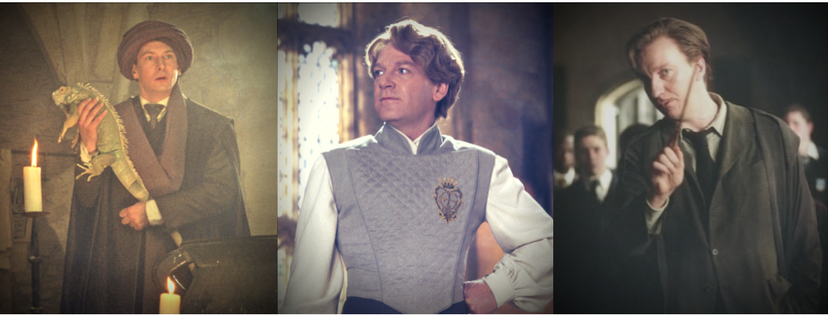 Now there is one last thing I want to talk about before I leave you to it. And that is scale. Most of the franchise seem to be build around one statement and one statement only: The more the merrier. Just take a look at the casting list of Pirates of The Caribbean 2 vs. it’s predecessor. It almost doubled. Every time Hollywood gets it’s hands on a franchise they suddenly start to bring up side-characters, side-quests, side-stories. Without any need for them at all. Because all that does is to distract us from the main character.
Now there is one last thing I want to talk about before I leave you to it. And that is scale. Most of the franchise seem to be build around one statement and one statement only: The more the merrier. Just take a look at the casting list of Pirates of The Caribbean 2 vs. it’s predecessor. It almost doubled. Every time Hollywood gets it’s hands on a franchise they suddenly start to bring up side-characters, side-quests, side-stories. Without any need for them at all. Because all that does is to distract us from the main character.
Compare that to Harry Potter and the Chamber of Secrets where J.K. Rowling introduces just two new major characters. Gilderoy Lokchart and Tom Riddle. And one of them is a replacement for poor Professor Quirrell. That means, that most of the plot is wrapped around our three main protagonists Harry, Ron and Hermione (aka the ones that actually matter). And it works. Because the characters are strong and complex enough to stand on their own. You could tell a story of the three friends walking around in the forest and it would still be interesting…oh wait scratch that. But you get the point. Additional characters don’t further your plot, they don’t enhance the intensity of the story. They are cunning devise to try to avoid to deal with the main protagonist.
So if you are writing a sequel try the following. You are only allowed to replace the characters that died or disappeared in the original story and add one additional character. Like in Chamber of Secrets or in Prisoner Of Azkaban where you have Lockhart who is replaced by Lupin, Tom Riddle who is replaced by Wormtail and the one we want to add is Serius Black. No that is strong writing. To be able to trust your characters beyond explosion and action scenes and to be able to explore them even in the silent moments, where there is no distraction.
WHAT WE’VE LEARNED
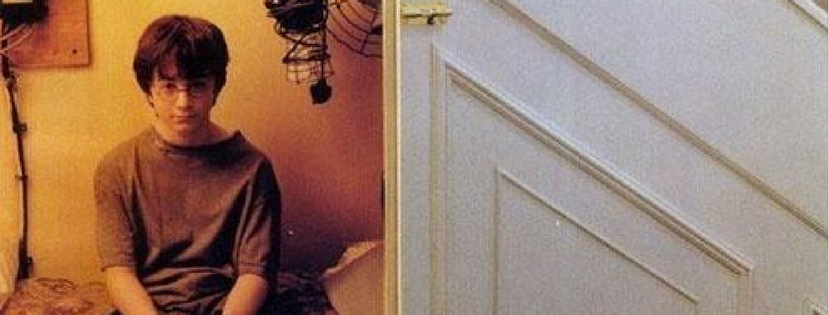 There are two reasons why people come back to see more. The story and the characters. You can make up the most hideous things (like a time-traveling necklace), as long as you stay true to the story and the character you created in the first place. People want to see something new, sure. But when they let their imagination flow, they don’t come up with new interesting side character. They make up stories of who is going to pair up with whom. They stay within the boundaries of the world you created. And so should you!
There are two reasons why people come back to see more. The story and the characters. You can make up the most hideous things (like a time-traveling necklace), as long as you stay true to the story and the character you created in the first place. People want to see something new, sure. But when they let their imagination flow, they don’t come up with new interesting side character. They make up stories of who is going to pair up with whom. They stay within the boundaries of the world you created. And so should you!
Because as I said. Sequels are awesome. If they are done right!

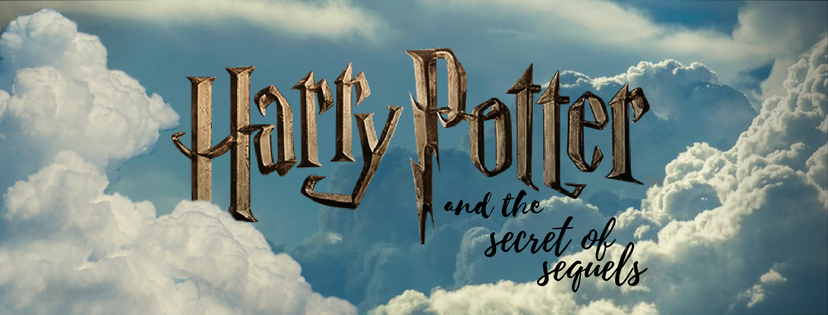
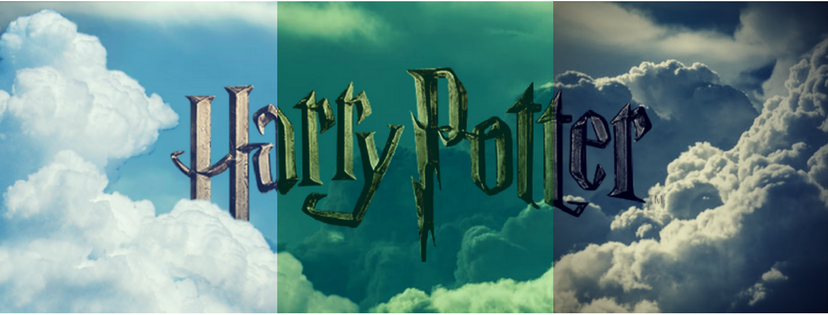
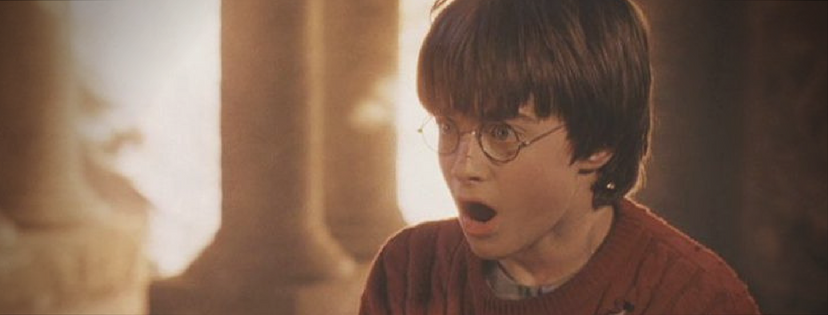
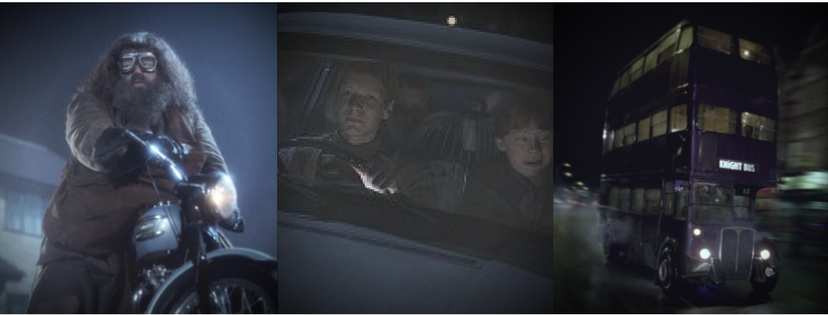



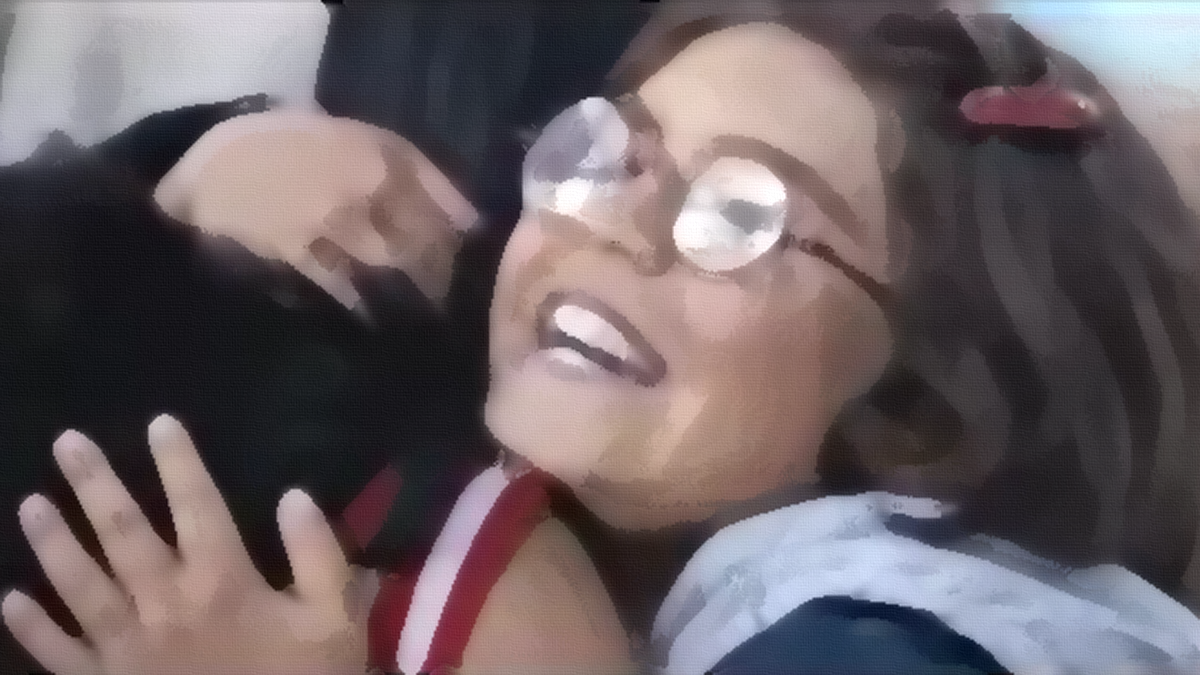

No Comments